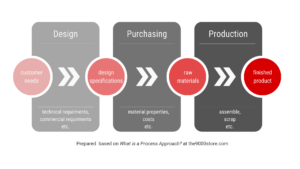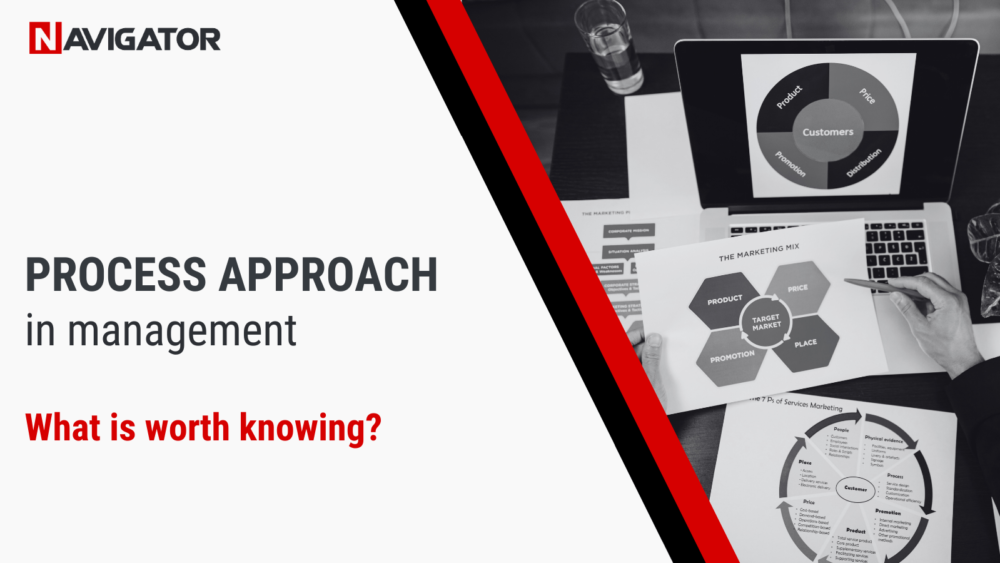Is it possible for a company not to manage individual departments but to focus on whole sequences of activities? Or is an organization capable of functioning without classic vertical dependencies? These are just some of the ideas that the process approach proposes. What can we expect from it in practice? Be sure to read our text.
What is the process approach?
In the process approach, an organization manages tasks through a system of processes. The division into departments or products is rather avoided. All efforts are focused on getting the process design right. Once this is done, you can expect good results from the activities. Just like when cooking – from a well-described recipe you can expect a delicious cake.
Organizational activities are treated as an interrelated network of tasks, rather than individual issues. Simply put, one looks at the bigger picture to understand how each activity contributes to organizational goals.
This is why the process approach so rarely mentions departments or products. The idea is to avoid “information silos“. The priority is for each process to provide the next process with exactly what it needs.
What is the goal of the process approach?
The process approach is to streamline the workflow of an organization. As mentioned above, it’s about aligning the needs of the various processes with each other. Eventually, the organization can work in synergy (where 2 + 2 = 5). That is, to work out the kind of results employees could not manage to do divided into traditional teams.
The graphic below shows how the process approach to management can work in practice.

The stages of work on a product, until it’s delivered to the market, are connected and function as one large process. Employees with specific specialties provide others with what is necessary to complete the next step in the process. The result is a finished product.
Process approach in management – what it is about
ISO standards tell us what the process approach in management should look like. We’re talking specifically about ISO 9001:25, which proposes the PDCA approach.
Process management in ISO 9001:2015 standard according to the PDCA method:
P (plan) – plan the goals and the processes that will lead to them (“What do I want to achieve and how will I achieve it?”).
D (do) – put the planned activities into practice.
C (check) – control processes and measure their performance against requirements and goals.
A (act) – take proactive measures to continuously improve processes.
Process approach advantages and disadvantages
In ISO, we can also find the potential advantages that the process approach can bring. First of all, it makes it possible to implement any management system more quickly. This is due to its flexibility.
The second is that it is easier to meet the needs of customers, which implies customer satisfaction. In the process approach, communication improves not only between employees.
The quality control proposed in the PDCA method, on the other hand, makes the entire organization more confident in its decisions. At the end of the day, we deliver exactly the product that customers want, and in the best possible way.
The disadvantages of the process approach are not talked about much, but it is important to remember that they also exist. First of all, this style of management may not fit every company. For example, an environment with a hierarchical organizational culture may not find its way into a dynamic work system, where classic job relationships are abandoned.
Process approach vs. functional approach
The differences between the functional and process approaches are noticeable. Companies operating under the functional approach have a traditional structure. Employees are arranged hierarchically. Thus, the management system is clear, and dependency runs vertically. Lower positions report the results of their work to higher ones.
In contrast, process-oriented companies favor processes over hierarchies. Attention is mainly focused on results and customer satisfaction. Activities such as order management and taking care of product resources are at the forefront. The process approach runs horizontally. People from different departments can participate in the same process, unlike the functional model.
Process approach vs. system approach
Both process and systems approaches try to improve operations in a company, but they do so in different ways. The process approach focuses on improving specific steps in the work, while the systems approach looks at the entire structure and how different areas of the organization interact with each other.
Process approach examples
An example of the process approach and how to apply it can be found not only in private companies but also in universities. Guide No. 544R2 of the ISO/TC176 committee suggests dividing academic processes into:
– University management processes, such as creating strategy, planning goals, providing internal communication, and providing resources.
– Management of resources – such as human resources, infrastructure, working conditions, materials and finances – necessary to carry out other processes.
– Operational processes related to the provision of university services.
– Monitoring, analysis and improvement processes, including performance measurement, corrective actions and data analysis.
Process approach – how to implement
The implementation of the process approach should start with the identification of key processes. “Key processes” are those that have the greatest impact on the company’s profitability and contribute most to the achievement of strategic goals.
Once identified, the flow of processes should be mapped. You need to understand what their roles, dependencies and interactions are. In this step, it is best to engage all the people that the process will involve.
Of course, it’s also worth monitoring whether the new approach is working properly. Especially if you are implementing it for the first time, there may be a few stumbles along the way. Alternatively, it may turn out that the process approach is not what your organization needs.
To implement the process approach as smoothly as possible, it’s worth getting a workflow platform for handling electronic information flow, such as NAVIGATOR from Archman. The first step to avoiding “information silos” is a dynamic flow of documents, tasks and procedures. Digitization and workflow will be ideal here.
Next comes the creation of custom processes. NAVIGATOR facilitates this with its original workflow solution. Finally, all that remains is to monitor how the new approach performs. After a few months of implementation, it’s worth creating some reports and analyses on efficiency. It’s best to put them in measurable categories to make sure the evaluation is based on facts.
Thank you for reading the article. Get to know more about Electronic Workflow, AI, Business Intelligence and No-code applications in NAVIGATOR system
Sources:
- Cameron, K.S., Quinn, R.E., (2003) Kultura organizacyjna – diagnoza i zmiana. Kraków: Oficyna Ekonomiczna.
- blog.wearedrew.co/en/management-by-processes-vs-functional-management(access: 13.02.2024)
- iso.org/files/live/sites/isoorg/files/archive/pdf/en/iso9001-2015-process-appr.pdf(access: 13.02.2024)
- ruj.uj.edu.pl/xmlui/bitstream/handle/item/129867/jedynak_podejscie_procesowe_w_zarzadzaniu_uniwersytetem_2019.pdf?sequence=1&isAllowed=y(access: 13.02.2024)
- the9000store.com/iso-9001-2015-requirements/iso-9001-2015-context-of-the-organization/what-is-a-process-approach/(access: 13.02.2024)
He feels best creating, that’s why he is in charge of creative marketing at the company. He writes a lot – mostly popular science articles for Holistic.news but other times fantasy "drawer novels". He also designs tabletop games and likes to treat it as a "break from digitization".





